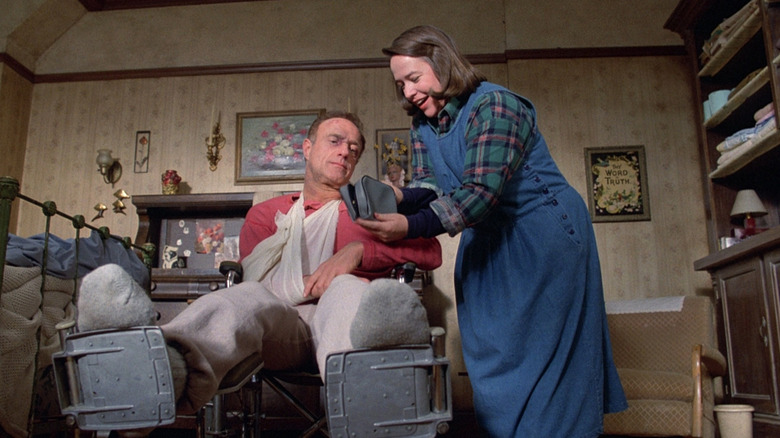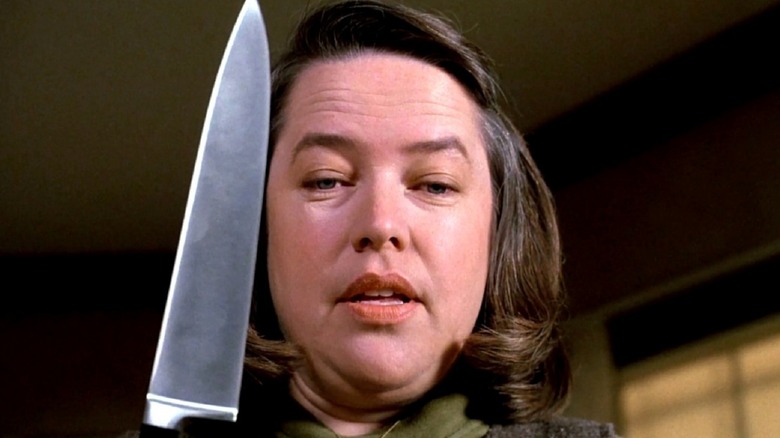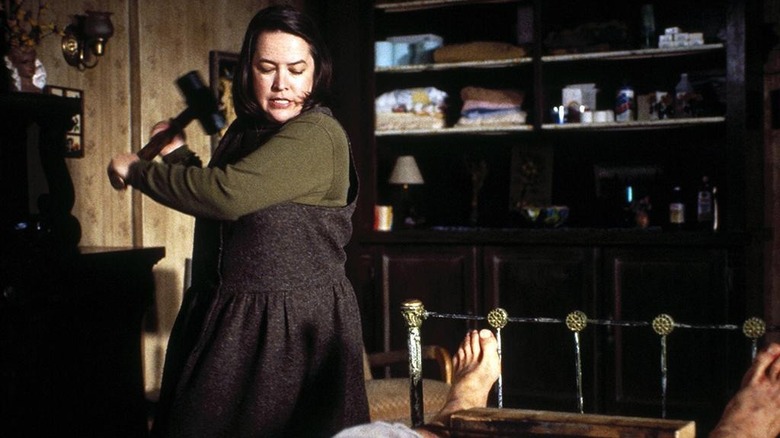Misery's Most Famous Scene Cost The Film Its First Director
When you think of the movie "Misery," one terrifying scene likely comes to mind. It's the scene when Annie, the deranged captor and "biggest fan" of historical romance novelist Paul Sheldon (James Caan), violently prevents him from trying to escape. Kathy Bates' performance is utterly chilling as her honeyed voice details a practice in African diamond mines called "hobbling" that stopped workers from running away with the jewels. As she cooly explains the brutal ritual, director Rob Reiner heightens the tension by gradually pulling in closer and closer to Paul's anguished face and Annie's calculating sneer. Against the eerily calm background music of Beethoven's "Moonlight Sonata," Annie gently reassures Paul that what she is about to do is for the best, then swings a sledgehammer and viciously breaks his ankles.
The harrowing scene is quite different in Stephen King's novel version. In the book, Annie cuts off Paul's foot with an axe and cauterizes the stump with a blowtorch, and later cuts off his thumb. Screenwriter William Goldman was excited about bringing this to life on screen, but he would soon discover that not everyone working on "Misery" felt the same way about the nightmarish sequence.
George Roy Hill refused to film the hobbling scene
George Roy Hill was set to direct "Misery" but abruptly pulled out because of the hobbling scene. "I was up all night. And I just could not hear myself saying, 'Action!' on that scene," Hill said according to Goldman's book "Which Lie Did I Tell? More Adventures in the Screen Trade." Hill was not the only one who opposed the scene; Bette Midler turned down the role of Annie because she "didn't want to saw off someone's foot" (via The New York Times). Warren Beatty was interested in playing Paul, but he was concerned about the hobbling scene and its effect on the character: "Beatty's point was this: He had no trouble losing his feet at the ankles, but know that if you did that the guy would be crippled for life and would be a loser," Goldman writes.
All of this resistance forced Goldman and Reiner to question how closely they should follow the novel. Reiner polled everyone at his production company Castle Rock about whether or not they should change the gruesome scene. Eventually, Reiner and producer Andrew Scheinman re-wrote the script without Goldman. They sanitized King's version by having Paul suffer two broken ankles instead of a chopped off foot. By the end of the film, Paul regains enough mobility to murder his abductor, bashing Annie's head with a typewriter and one of her beloved pig statues.
The scene's legacy
In the DVD commentary (via Yahoo!), Reiner explains his decision to alter the scary hobbling scene:
"We wanted Paul Sheldon at the end of this movie to emerge victorious over Annie Wilkes, and if he wound up without a foot ... then he maybe paid too high a price for that. Most of the people who have seen this movie say it was pretty darn painful to look at, so I don't think we compromised it too much."
According to his book, Goldman was initially devastated by the changes but came to appreciate them:
"I was wrong. It became instantly clear when we screened the movie. What they had done ... worked wonderfully and was absolutely horrific enough. If we had gone the way I wanted, it would have been too much. The audience would have hated Annie and, in time, hated us."
The ankle-breaking allowed "Misery" to have a more uplifting ending where Paul emerges a hero and Annie is never able to truly best him. It is easier for Paul to put the horrifying ordeal behind him, rather than live with a grim reminder for the rest of his life.
Keeping King's version of the scene could have made it harder for audiences to see Annie as anything but a malevolent villain, unable to empathize with the broken woman inside — her deep loneliness and delusion. Bates was not afraid to highlight Annie's evilness, telling Access Hollywood (via Yahoo), "I always really thought that Annie should have cut his foot off." But hobbling is such a strange, sinister act of violence that it still makes for a cringe-worthy and unforgettable scene.


